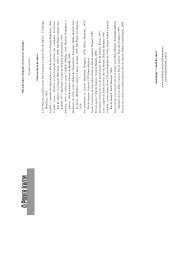1 - No-IP
1 - No-IP
1 - No-IP
You also want an ePaper? Increase the reach of your titles
YUMPU automatically turns print PDFs into web optimized ePapers that Google loves.
7. Which of the following statements is incorrect?<br />
a) The transition countries report an estimated one million HIV/AIDS<br />
cases.<br />
b) One fourth of infections reported between 1997 and 2000 in<br />
Commonwealth of Independent States were among women.<br />
c) Injecting drug users are one of the reasons for HIV/AIDS<br />
transmission.<br />
d) In Commonwealth of Independent States countries heterosexuals<br />
are the cause of all officially registered infections.<br />
e) More than one in every 1000 people in Estonia are infected with<br />
HIV/AIDS.<br />
8. Which of the following is not stated as a reason for HIV/AIDS<br />
infection in Eastern Europe and Commonwealth of Independent<br />
States?<br />
a) A growing number of sex workers.<br />
b) Heterosexual contact with injecting drug users.<br />
c) Insufficiently effective public intervention.<br />
d) A low awareness of the need to use condoms.<br />
e) The growing number of poor people in the region.<br />
9. According to the information in the article,<br />
a) nine out of ten HIV/AIDS cases in the transition countries are in<br />
Russia and Ukraine.<br />
b) in 2001 there were 700,000 HIV/AIDS cases in the transition<br />
countries.<br />
FGV<br />
AIDS Spreading in CIS ‘Virtually Unchecked’<br />
1. GENEVA (Reuters) – The HIV/AIDS epidemic has exploded in Eastern Europe and Commonwealth of Independent<br />
States, posing the greatest health threat to youth in the region, the United Nations said on Wednesday. In a report,<br />
the U.N. Children's Fund (UNICEF) warned that the killer disease was spreading "virtually unchecked" into the wider<br />
population through heterosexual contact with injecting drug users.<br />
2. Russia and Ukraine account for nine-tenths of the estimated one million HIV/AIDS cases in the 27 transition countries,<br />
according to UNICEF's Social Monitor 2002. The figure, through 2001, compares to 700,000 a year earlier and<br />
420,000 in 1998.<br />
3. "HIV is spreading at a faster rate in some countries in the region than in any other part of the world," UNICEF said.<br />
"The HIV epidemic is the biggest threat to young people's health in the region...There is also little evidence that public<br />
interventions to halt the spread of HIV in the hardest hit countries have been sufficiently effective."<br />
4. Estonia has the region's highest rate of new HIV infections, with more than one in every 1,000 people infected in<br />
2001 – almost 20 times the average rate in the European Union, according to the report produced by UNICEF's<br />
Innocenti Research Center in Florence, Italy.<br />
5. In the CIS countries, a quarter of all officially registered infections between 1997 and 2000 were among women,<br />
suggesting increasing heterosexual transmission, it said. But awareness of the need to use condoms to prevent transmission<br />
remains poor in the region, where both the number of sex workers and injecting drug users is growing, it said.<br />
c) of every 1000 people infected with HIV/AIDS in 2001, one is from<br />
Estonia.<br />
d) twenty times more people are infected with HIV/AIDS in the<br />
European Union than in Estonia.<br />
e) one quarter of all women infected with HIV/AIDS between 1997<br />
and 2000 were heterosexuals.<br />
10. "20 times" in paragraph 4 refers to:<br />
a) the average number of times European citizens must be exposed to<br />
HIV before they become infected.<br />
b) the rate of HIV infection in the European Union, which is twenty<br />
times that of Estonia.<br />
c) the fact that if one out of every 1000 people are infected with HIV<br />
in Estonia, then twenty out of every 1000 are infected in the<br />
European Union.<br />
d) the rate of new HIV infections in Estonia compared to that of the<br />
European Union.<br />
e) the number of HIV infections per 1000 people in Europe,<br />
especially Italy.<br />
11. Which of these areas has been least affected by the HIV/AIDS<br />
epidemic in recent years?<br />
a) The Ukraine.<br />
b) The Commonwealth of Independent States.<br />
c) The European Union.<br />
d) Eastern Europe.<br />
e) Estonia.<br />
– 19 INGLÊS E









